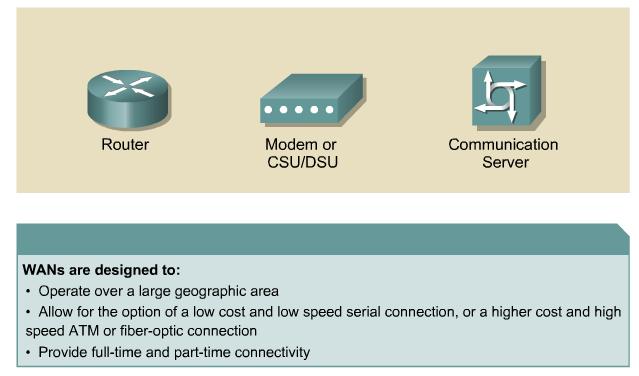Chap1:Wan and Routers
From Mycomputer Notes
A wide-area network (WAN) is a data communications network that connects user networks over a large geographical area. WANs have several important characteristics that distinguish them from LANs. In this module is about providing an overview of WAN technologies and protocols.
This module is about understanding the physical layer components of a router. This knowledge builds a foundation for other information and skills that are needed to configure routers and manage routed networks.
Contents |
[edit] WAN
- WAN
- Data communications network that spans a large geographic area such as a state, province, or country. WANs often use transmission facilities provided by common carriers such as telephone companies.
These are the major characteristics of WANs:
- They connect devices that are separated by wide geographical areas.
- They use the services of carriers such as the Regional Bell Operating Companies (RBOCs), Sprint, MCI, and VPM
Internet Services, Inc. to establish the link or connection between sites.
- They use serial connections of various types to access bandwidth over large geographic areas.
[edit] Difference between a LAN & WAN
A WAN operates at the physical layer and the data link layer of the OSI reference model. It interconnects LANs that are usually separated by large geographic areas. WANs provide for the exchange of data packets and frames between routers and switches and the LANs they support.
The following devices are used in WANs:
- Routers offer many services, including internetworking and WAN interface ports.
- Modems include interface voice-grade services, channel service units/digital service units (CSU/DSUs) that interface T1/E1 services, and Terminal Adapters/Network Termination 1 (TA/NT1s) that interface Integrated *Services Digital Network (ISDN) services. Communication servers concentrate dial in and dial out user communication.
WAN data link protocols describe how frames are carried between systems on a single data link. They include protocols designed to operate over dedicated point-to-point, multipoint, and multi-access switched services such as Frame Relay. WAN standards are defined and managed by a number of recognized authorities, including the following agencies:
- International Telecommunication Union-Telecommunication Standardization Sector (ITU-T)
formerly the Consultative Committee for International Telegraph and Telephone (CCITT)
- International Organization for Standardization (ISO)
- Internet Engineering Task Force (IETF)
- Electronic Industries Association (EIA)
[edit] Introduction to routers in a WAN
A router is a computer like a PC, but designed to perform more specific functions that are not performed by desktop computers, (i.e routers connect and allow communication between two networks and determine the best path for data to travel through the connected networks).
Routers need their own Internetowork Operating System IOS software to run configuration files. The configuration files contained instructions and parameters that control the flow trafic in and out of the routers. Routers used Routing protocols to determined the best path for packets. The configuration file specifies all the information for the correct setup and use of the selected, or enabled, routing and routed protocols on a router.
The main internal components of the router are
RAM has the following characteristics and functions:
- Random-access memory (RAM)
- Nonvolatile random-access memory (NVRAM)
- Flash memory, read-only memory (ROM),
- Interfaces.
- Stores routing tables
- Holds ARP cache
- Holds fast-switching cache
- Performs packet buffering as shared RAM
- Maintains packet-hold queues
- Provides temporary memory for the configuration file of a router while the router is powered on
- Loses content when a router is powered down or restarted
NVRAM has the following characteristics and functions:
- Provides storage for the startup configuration file
- Retains content when a router is powered down or restarted
Flash memory has the following characteristics and functions:
- Holds the IOS image
- Allows software to be updated without removing and replacing chips on the processor
- Retains content when a router is powered down or restarted
- Can store multiple versions of IOS software
- Is a type of electrically erasable programmable read-only memory (EEPROM)
ROM has the following characteristics and functions:
- Maintains instructions for power-on self test (POST) diagnostics
- Stores bootstrap program and basic operating system software
- Requires replacing pluggable chips on the motherboard for software upgrades
Interfaces have the following characteristics and functions:
- Connect routers to a network for packet entry and exit
- Can be on the motherboard or on a separate module
[edit] Segmentation with Routers
Routers can be used to segment the LANs but they are mainly used as WAN devices. In this section will review how routers are used in a LAN environment. Routers have both LAN and WAN interfaces. WAN technologies are frequently used to connect routers. Routers use WAN connections to communicate with each other. The two main functions of a router are the a) selection of best path and b) the switching of packets to the proper interface. To accomplish this, routers build routing tables and exchange network information with other routers. The routing tables can be maintained statically (set up by the administrator) or dynamically through the use of a routing protocol that exchanges network topology information with other routers.
A correctly configured internetwork provides the following:
- Consistent end-to-end addressing
- Addresses that represent network topologies
- Best path selection
- Dynamic or static routing
- Switching




